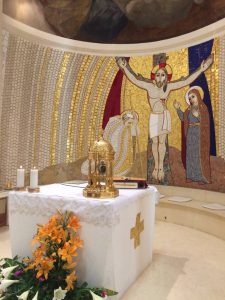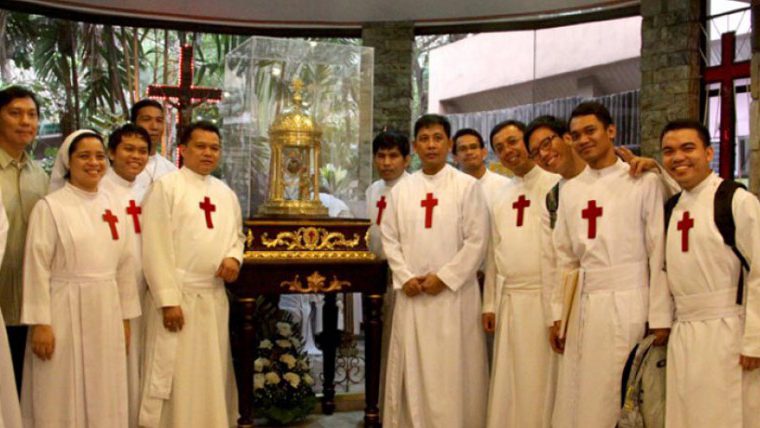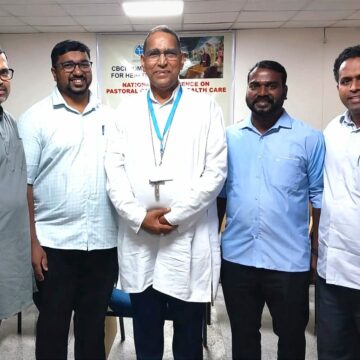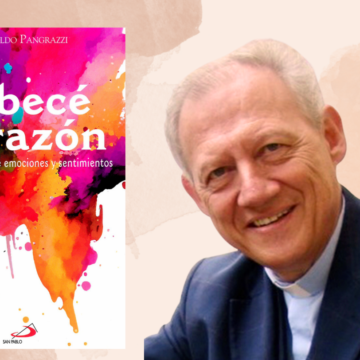 St. Camillus de Lellis (1550–1614) – who received the epithet ‘the Giant of Charity’ – greatly contributed to the reform of the health-care system of his time and thereby gave an impulse to the Catholic Counter-Reformation at the end of the sixteenth century, placing at the centre of every project of care the sick person, understood in the fullness of his or her physical, moral, spiritual and relational dignity. For Camillus, ‘the rights of the weak were not weak rights’; indeed, they were the reason why his heart beat with greater vitality and great passion.
St. Camillus de Lellis (1550–1614) – who received the epithet ‘the Giant of Charity’ – greatly contributed to the reform of the health-care system of his time and thereby gave an impulse to the Catholic Counter-Reformation at the end of the sixteenth century, placing at the centre of every project of care the sick person, understood in the fullness of his or her physical, moral, spiritual and relational dignity. For Camillus, ‘the rights of the weak were not weak rights’; indeed, they were the reason why his heart beat with greater vitality and great passion.
The heart of St. Camillus, and here I cite one of the great historians of the Order, ‘was full of charity towards everyone: an ordered charity that proceeded from God and returned to God, through His creatures, to all of whom he did good, without the reservations of selfishness. A charity that was so extraordinary that it persuaded its witnesses that the heart of Camillus had to bear a visible sign of that charity. Thus it was that after the death of the saint there was a wish to see his heart: ‘it was so beautiful – one witness declared – that it seemed a ruby, and so large that everyone admired it’. Providence intervened in favour of the saint, and above all of his sons, allowing the heart of Camillus to be conserved, and still conserved, for their admiration and devotion’ (M. Vanti, Lo Spirito di San Camillo, 1986 [fifth edition], pp. 379–380).
The relic of the heart of St. Camillus is kept permanently at the generalate house of the Order of the Ministers of the Sick (the Camillians) which was founded by St. Camillus at the end of the sixteenth century to serve sick people in body and spirit through a variety of services. The relic is rightly kept in the room that was the infirmary of the community and the place where Camillus spent the last days of his life. This room (Cubiculum) was transformed over time into a small private chapel. It was richly decorated during the Baroque period and later made more beautiful with eighteenth-century pictures. Nothing, however, can compete with the beauty of the heart of Camillus which is placed in the centre of the Cubiculum and is an eternal testimony to the greatness of Camillus de Lellis.[1]
For the history of this relic we can draw upon Fr. Sanzio Cicatelli, a contemporary of Camillus who every day wrote down what he observed about the Founder Father, compiling a valuable ‘manuscript’ which enabled him to print a biography of Camillus immediately after his death. When speaking about the removal of the heart, he tells us what was stated by Fr. Giacomo Mancini, a figure who at the moment of the death of Camillus was the prefect of the generalate house of Rome. In order to satisfy curiosity about the death of the saint, but above all else to take out his heart and conserve it as a relic, two surgeons of the Hospital of the Holy Spirit of Rome, where Camillus had served the sick for a number of decades, were called: Dr. Girolamo Bianchi, a consultant, and his assistant, Michele Ercolini, both of whom were very devoted to the saint. The original text reads as follows: ‘he was opened in order to see which malady had caused his death, and given that he died with the reputation of holiness, it was decided that the heart should be taken, and that it should be conserved, hoping that one day it would serve as information about his rare actions by which he would be beatified, and thus in my presence, after the heart was taken from the body it was placed in a basin, and on it were placed a few herbs and from there it was placed in a box made of cypress, and it was said by the fathers that it should be sent to Naples to be a part of the body of the House for the Professed which was the second house that Camillus had founded’. As soon as it was taken out, the heart was so red that ‘it seemed a ruby and it was so large that those who saw it admired it’. After being placed in valuable casket made of cypress, this precious relic was entrusted to Fr. Giovanni Califano, who wrote: ‘the heart, which I testify was given to me because of my devotion and because of the belief in his holiness that I had, and I have, and out of devotion I asked permission from the Superiors to take it to Naples as a relic, and this was granted to me, and I took it to Naples’.
Apart, however, from the historical truth of the matter, the real message that the presence of the heart wants to offer to believers is the deep meaning that the presence of the heart suggests to all of us: Camillus himself often repeated, above all to those who cared for sick people, ‘more heart in those hands, brothers’. He wanted to say that every deed of our lives has a value only if it is done with love and with joy, and even more when these deeds are done for those who suffer and expect from us a touch and a smile.
The relic of the heart of St. Camillus draws its meaning from the heart of Jesus, a ‘burning furnace of charity’ as we say in the litanies of the Sacred Heart. Without reference to the heart of Jesus, one could not explain the charity itself of our saint: ‘a charity that proceeded from God and returned to God through love of neighbour, especially of the sick poor in whom he saw the image itself of his Lord’.
In the Old Testament, reference is made twenty-six times to the heart of God, which is seen as the organ of His will: it is by the heart of God that man is judged. Because of the pain that the heart of God feels because of the sins of men, God decides to send the Flood, but He is then moved by human weakness and forgives. And there is a text in the Old Testament in which the subject of the heart of God is expressed is an absolutely clear way. We find it in chapter eleven of the book of the Prophet Hosea where the first verses describe the dimension of the love with which God addresses Israel at the dawn of its history: ‘When Israel was a child, I loved him, and out of Egypt I called my son’ (v. 1). In truth, the response of Israel to this untiring divine predilection is indifference and even ingratitude, ‘But the more they were called, the more they went away from me’ (v. 2). However, God never abandons Israel to the hands of enemies because ‘My heart is changed within me; all my compassion is aroused’ (v. 8).
 The heart of God is aroused with compassion! The heart of Jesus offers to our contemplation the mystery of the heart of a God who is moved and pours all of His love over humanity. This is a merciful love which in the gospel is revealed to us as the incommensurable passion of God for man. He does not surrender in the face of ingratitude and not even in the face of the refusal of the people that He has chosen. Indeed, with infinite mercy He sends into the world His only begotten Son so that he would take upon himself the destiny of destroyed love, and so that, in destroying the power of evil and death, he could restore the dignity of being children to human beings who have been made slaves by sin. Yet all of this is at a heavy price: the only begotten Son of the Father immolates himself on the cross: ‘having loved his own which were in the world, he loved them unto the end’ (cf. Jn 13:1). A symbol of that love that goes beyond death is his side pierced by a spear (cf. Jn 19:34).
The heart of God is aroused with compassion! The heart of Jesus offers to our contemplation the mystery of the heart of a God who is moved and pours all of His love over humanity. This is a merciful love which in the gospel is revealed to us as the incommensurable passion of God for man. He does not surrender in the face of ingratitude and not even in the face of the refusal of the people that He has chosen. Indeed, with infinite mercy He sends into the world His only begotten Son so that he would take upon himself the destiny of destroyed love, and so that, in destroying the power of evil and death, he could restore the dignity of being children to human beings who have been made slaves by sin. Yet all of this is at a heavy price: the only begotten Son of the Father immolates himself on the cross: ‘having loved his own which were in the world, he loved them unto the end’ (cf. Jn 13:1). A symbol of that love that goes beyond death is his side pierced by a spear (cf. Jn 19:34).
In our Western culture, the heart has various meanings which are at times paradoxically contradictory: it is poetry for people in love, love for parents, research for medical science, hope for those who are waiting for a heart transplant, a lugubrious exhibition for the literature of horror, frenetic passion for the fans of the ‘secular relics’ of stars (often commercialised at auctions involving millions of pounds!), and life that is born and beats or at times is ripped from the maternal womb.
We are invited to attend the school of the heart of Christ to educate our hearts in compassionate pity, in that love which gives and that dedication which takes care of people who suffer. This is what is testified to, and proposed to us, by the heart of St. Camillus, which was shaped and transformed by the merciful heart of Christ.
The history of salvation, from Adam and Eve through Abraham, David, the Prophets and John the Baptist until the culminating point of Jesus Christ, is a long series of what the French call ‘estoire’: tales and history. We are all part of a great history and it is a truly wonderful tale. Within this great history there are many other tales that intersect with one another and deserve to be narrated, and amongst them there are also our personal journeys. Histories remind us how to climb into the spirit of each person and once we have arrived there we do not only become people who tell stories but also people who ensure that stories become real. I have always been fascinated by the fact that Jesus communicated many of his greatest teachings through stories (parables). And naturally enough the Gospel itself is the greatest story ever told, with its highs and lows of sufferings, of betrayals, of compassion and of mercy, always, however, dominated by love.
Beholding the relic of the heart of St. Camillus offers us a unique opportunity to tell the story of Jesus once again through the eyes of Camillus de Lellis. But it is also something more than telling or presenting history as we Camillians ourselves see it. We, too, become a part of a fascinated audience since the heart of Camillus obliges us to take note and to listen to the story of the man Camillus in whom that heart beat, of his charismatic and spiritual presence amongst the poor, the sick and those who were in need.
 It is in narrating anew the eternal story, and in listening to other people tell it, with their special shadings and nuances, that we begin to perceive the real depths of mystery, and through this we make ourselves more aware of its contents. In going back to narrating the story of Jesus, we highlight – obviously enough – out emphases and nuances. We are forced to reflect on our beliefs and – it is hoped – to be completely honest in the presentation of what follows. It will be our convictions that influence and challenge; at the same time, however, leaving us open to challenges, to dialogue and to an untiring search for Truth. We are all vulnerable pilgrims, ready to learn at any moment, while we try to decipher the mystery of Jesus.
It is in narrating anew the eternal story, and in listening to other people tell it, with their special shadings and nuances, that we begin to perceive the real depths of mystery, and through this we make ourselves more aware of its contents. In going back to narrating the story of Jesus, we highlight – obviously enough – out emphases and nuances. We are forced to reflect on our beliefs and – it is hoped – to be completely honest in the presentation of what follows. It will be our convictions that influence and challenge; at the same time, however, leaving us open to challenges, to dialogue and to an untiring search for Truth. We are all vulnerable pilgrims, ready to learn at any moment, while we try to decipher the mystery of Jesus.
When we go back to telling the story of Jesus, we become increasingly a part of what we share because of the fact that shared faith is placed under the microscope of our consciences and the eyes of other people. In narrating, we become more convinced of our faith, and we are once again deeply touched and encouraged by its daily expressions and by the authoritativeness and contemporary relevance that this message brings to today’s world. Thus public homage to the relic of the heart of St. Camillus offers us a possibility to narrate once again the story of Jesus Christ. This is a wonderful opportunity to evangelise, and to be evangelised, by those people who find in that heart welcome, consolation and a meaning to their lives!
I will end this paper with the good wishes that Camillus addressed to those who dedicated themselves to service to sick people. And who today does not have at home a child, an elderly person, a disabled person or a sick person? Thus ‘Happy and Blessed will you be if you can be accompanied to the tribunal of God by a tear, by a sigh, of one of these sick poor people! Be certain that you will go to enjoy God in eternity’.
[1] The heart is kept in a Murano glass casket which encloses the heart and has its shape and form. This casket of glass is 11cm high, 10cm wide and 7cm deep. The relic in the casket is designed like an ancient sacellum of the classical epoch. Four Doric columns form the base of the cupola, at the top of which is a cross, an important symbol of the Camillian Order. Inside the sacellum, two angels in an elegant and fine way support the casket and offer it to the visits of pilgrims and the faithful. The sacellum is 70cm high, 38cm wide and 34cm deep.















Camillians on Facebook
Camillians on Twitter
Camillians on Instagram